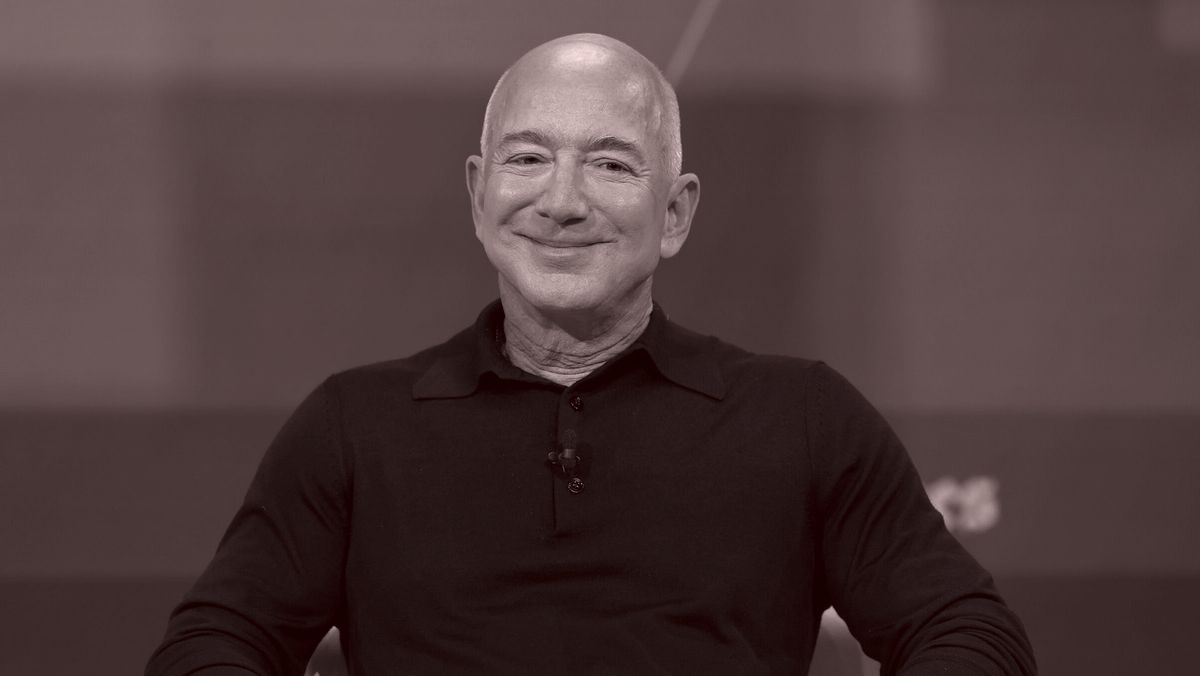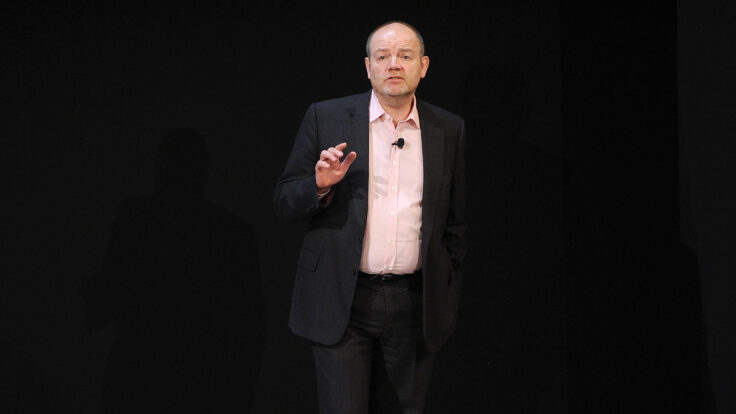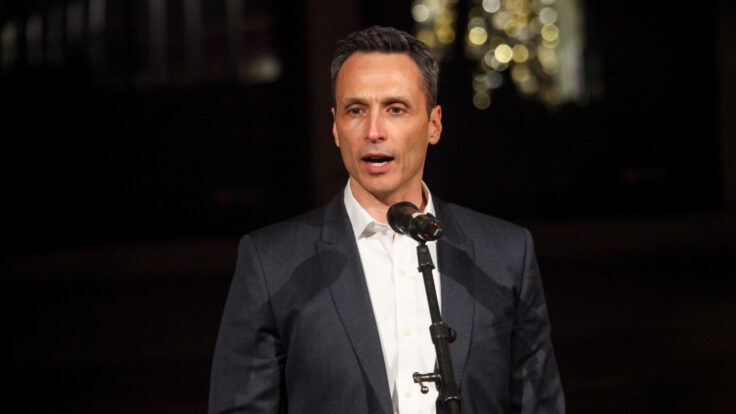Welcome back to The Best & The Brightest, I’m Abby
Livingston.
We’ve got a packed issue tonight. I’ve got the latest on all the vacancies and special elections vexing Democratic and Republican whips (has the vote margin ever been this uncertain?), plus what G.O.P. operatives are whispering about the timing of Elise Stefanik’s forthcoming resignation. Also up top: My partner William D. Cohan digs into how Elon Musk’s new status as D.C. wrecking-ball-in-chief is ricocheting on
Tesla shareholders. Then Dylan Byers brings it home with a close look at Jeff Bezos’s veritable DOGE-ifying of The Washington Post.
Let’s get started…
|
Johnson’s War of Inches & Stefanik Border Woes
|
The battle for control of the 119th Congress, which was already about as tight and
evenly divided as any Congress ever, became just a little more complicated this week, straining Mike Johnson’s three-vote margin and creating new headaches for whips on both sides of the aisle. Yesterday, the House honored Houston Democratic Rep. Sylvester Turner, who died on Wednesday from “enduring health complications,” according to a family statement—less than a year after the death of his predecessor in the 18th District, Sheila Jackson
Lee, who passed away from pancreatic cancer. A 70-year-old freshman, Turner ended up serving only 62 days in the House.
With Turner’s passing, there are now three official House vacancies: the Houston seat; Florida’s 1st, previously held by Republican Matt Gaetz, who resigned; and Florida’s 6th, which Mike Waltz abdicated to serve as Trump’s national security advisor. All three are safely ensconced in highly partisan geographies, and are not
expected to change parties, but they will be closely watched. Nevertheless, there’s a possibility that Republican Gov. Greg Abbott will keep Turner’s seat open until November, per KPRC, denying Democrats a vote until then.
That’s not the only looming margin complication: The Texas
Tribune reported last week that Republican Rep. Michael McCaul is in the running to serve as the Texas A&M University system’s chancellor, which would require him to resign his seat. The 10th district isn’t particularly competitive either—McCaul won his last election by nearly 30 points—but Democrat Mike Siegel came
within five points of unseating him in 2018, during the last Democratic wave. (The district was redrawn afterward.)
These vacancies serve as a reminder that when every single vote counts, the pressure falls to the whips. Right now, House Majority Whip Tom Emmer and his Democratic counterpart, Katherine Clark, have two of the hardest jobs in American politics. There may be more focus on the Republican whip counts, but Clark is tasked with disrupting
Republican vote-counting by herding as many Democrats as she can into the chamber for key votes. (That was illustrated last week when Colorado Rep. Brittany Pettersen and California Rep. Kevin Mullin dramatically raced across the country—Pettersen bringing a 3-week-old newborn to the House floor; Mullin with a post-op IV drip still in his arm—to bolster Democrats’ numbers when Republicans successfully passed their budget resolution.)
This battle of inches
is likely to continue throughout the 119th Congress, with both parties using every tool at their disposal to expand their margin. To wit: Senate Republicans are currently holding off on confirming New York Republican Rep. Elise Stefanik as the U.N. ambassador in order to postpone creating yet another vacancy. This race should not be competitive—Stefanik won reelection in November by 24 points—but there’s an opportunity for Democrats to experiment with messaging and fundraising
in Republican territory, playing off the economic turbulence that’s already buffeting Trump’s second term.
Seasoned political operatives predict the special election for Stefanik’s seat will be an early bellwether for where Republicans stand electorally, though none are going so far as to expect her seat will flip. As one Republican operative recently reminded me, Stefanik’s sprawling 21st District shares the state’s longest border with Canada, where even Republican voters are likely
worried about local repercussions from Trump’s trade war. Currently, insiders expect Stefanik to resign in May. By then, of course, the border economy could be in much worse shape.
|
|
|
A MESSAGE FROM OUR SPONSOR
|
Medicaid funding cuts
pose a threat to children, seniors, veterans, and people with disabilities.
|
|
|
And now, Bill Cohan tracks a DOGE ripple…
|
|
|

|
William D. Cohan
|
|
- Elon puts Tesla
on autopilot: Incredibly, Elon Musk seems to be shaking off the precipitous decline in his personal net worth—some $80 billion in the first two months of the year—which is intimately tied to the plunging value of Tesla stock. He’s still the world’s richest person, of course, with a net worth estimated at $350 billion, but it’s notable that there hasn’t been any real pushback from shareholders, or from the Tesla board, on Elon’s political antics. As my partner Peter
Hamby recently reported, a majority of likely voters (51 percent) disapprove of Musk’s role with the Trump administration, and 57 percent disagree with his dismantling of federal agencies.
The impacts are real: Tesla sales have
reportedly dropped by double digits in true-blue California, the largest U.S. market for EVs. January sales were down 45 percent year over year in Europe, where protesters have been demonstrating outside Tesla showrooms and factories, even as the EV market is growing. (Tesla registrations dropped
76 percent in Germany last month, following Elon’s endorsement of the far-right Alternative for Germany party in the recent elections.) Meanwhile, it’s not like consumers who are fed up with Elon don’t have plenty of cheaper, less politically toxic alternatives. In China, for example, Tesla is hemorrhaging
market share to BYD, a less expensive, domestically produced rival. (BYD’s sales were up nearly 100 percent year over year in Germany last month.)
Since Trump’s inauguration, Tesla’s shares are down an extraordinary 29.2 percent, while the S&P 500 index is down only 1.7 percent. In February, Tesla lost more of its market value—$359 billion—in a single month than any company in history, besting Nvidia’s $347 billion drop in January. Of course, the Tesla stock was up 71 percent in 2024,
with most of those gains—69 percent—coming after November 5. If some of that gain gets dissolved, I guess it’s not the end of the world, but it’s a rude awakening for the retail investors who piled in after Trump, and Elon, took the Oval. —William D. Cohan
|
|
|
The latest news and notes from the Post in-crowd and
D.C. haut monde about Bezos’s intentions and opportunities.
|
|
|
On Sunday evening, about 100 hours after Jeff Bezos set off a
fresh round of hysteria at The Washington Post, several prominent members of the Washington haut monde gathered at the Kennedy Center to honor the legacy of one of his more universally beloved predecessors, the late Katharine Graham. The event, which featured a screening of a new documentary about her legendary stewardship of the paper—through Nixon, the Pentagon Papers, Watergate, and so on—was hosted by Graham’s old friend
Warren Buffett and attended by the likes of Bill Gates, David Rubenstein, Tony Blinken, and Sally Quinn, the writer and widow of Ben Bradlee who has served for decades as Washington’s imperial hostess.
Katie Robertson, who covered the event for the Times,
noted the conspicuous absence of Bezos (who was at the Oscars) and Post publisher Will Lewis and executive editor Matt Murray, who would have been persona non grata among this crowd. (Murray later said he missed the screening due to an illness.) Robertson also seemed to appreciate the obvious
juxtaposition on display that evening. Yes, it was a celebration, but also “a wake for an era that has long since passed.”
|
|
|
A MESSAGE FROM OUR SPONSOR
|
Medicaid funding cuts
pose a threat to children, seniors, veterans, and people with disabilities.
|
|
|
Indeed, Bezos’s recent decision to refashion the Post’s Opinion section
as another Wall Street Journal–esque bastion for “personal liberties and free markets” seems to be the final and most severe obstacle between the Post that he’d acquired from the Graham family for $250 million, in 2013, and the media company that he now aspires to create: a one-way door, in his parlance. Friends and associates of Bezos debate whether the new mandate is motivated by brazen Trump sycophancy, a pragmatism about Amazon and Blue Origin’s government
contracts, his longheld libertarian philosophy, or some combination of these factors. Nevertheless, the rupture has been nothing short of traumatic for Post veterans and the broader Washington establishment, many of whom believed that Bezos was a modern version of Kay Graham—a role he quite capably cosplayed during the first Trump administration—until they realized he wasn’t.
|
Unsurprisingly, Graham’s name has come up a lot in recent days. “Now we know
that Bezos is no Katharine Graham,” Marty Baron, the storied editor who led the Post through its “Democracy Dies in Darkness” phase, wrote this week in The Atlantic. “It has been sad and unnerving to watch Bezos fall so terribly short of her standard
as he confronts the return of Donald Trump to the White House. It’s been infuriating to observe the damage he has inflicted in recent months on the reputation of a newspaper whose investigative reporting has served as a bulwark against Trump’s most transgressive impulses.” On X, Peter Baker, the D.C. establishmentarian who spent 20 years at the Post before joining the Times, said the new Graham documentary “reminds us of what it was like to have a person of
principle and courage own the Washington Post.”
On Tuesday, in one of the more bemusing acts of protest, former Post managing editor Cameron Barr wrote a column for U.S. News & World Report in which he restated his own professional disassociation from the paper where he’d been on contract since
stepping down in 2023. His most memorable assignment, of course, was leading the Post’s own investigation into Lewis during the newsroom’s hysteria over Lewis’s past life as a Murdoch deputy amid the phone-hacking scandal. As a kicker, Barr intimated, albeit half-heartedly, that Bezos should sell the paper.
Barr is smart enough to know that a sale is not in the cards, just as Baron must surely know that his public criticisms aren’t going to inspire his
former boss to have a come-to-Jesus moment. Indeed, Bezos’s current transformation of the Post is only just beginning. And while it can be hard to fathom that the origin of this bewildering journey dawned with Lewis’s infamous managerial snafus, the defection of dozens of the paper’s most high-profile journalists, and the loss of hundreds of thousands of angry subscribers, Bezos is ostensibly playing for a future that’s bigger than most of the paper’s existing and
former staff have probably countenanced.
After all, he isn’t Patrick Soon-Shiong, a proper billionaire but one who still feels the sting of his $500 million misadventure with the LA Times, or even Laurene Powell Jobs or Marc Benioff—who appear willing to nurture less expensive and expansive legacy magazine brands into a new age with a polite mix of tenderness and expectation. Instead, he’s about seven or eight times wealthier
than the three of them combined, and fresh off a midlife crisis that seemingly inured him to public opinion.
While Post veterans hem and haw over the paper’s legacy, Bezos surely sees the broader context. Even in that halcyon Baron-Trump era, when the Post was growing subscriptions 50 percent year over year, the business never really came within spitting distance of the Times, which has dominated the market for sophisticated liberal-inflected news and lifestyle
content, and is likely to do so for the foreseeable future. But despite all its success, even the Times has proved that this total addressable market is smaller than many had imagined—and, perhaps, not hospitable to multiple participants. At least 50 percent of the country will likely never tolerate the Times, no less pay for a subscription. And while that might be tolerable for the Sulzbergers, who still feel the twinge of nearly losing the asset more than a
decade ago, it’s probably not palatable to the world’s third-wealthiest man.
|
|
|
The Post, for its part, has been evidencing these market signals
for years—declining traffic, churning subs, losing around $100 million per year—and pointing fingers at the potential culprits while it slides down the greasy pole. Was it C.E.O. Fred Ryan’s fault? What about executive editor Sally Buzbee? After their departures, Lewis found himself in the center of a circular firing squad. But what if the real economic problem, at least for Bezos, was the market where the Post had positioned itself?
|
One of the ironies of the Post’s troubles, of course, is that so many
beleaguered employees fought for Bezos’s attention for so long that they may not have realized what it entailed. Now that he appears dug in, or at least as engaged as he’s been in years, Bezos has expressed a desire to tinker with his paper—moving it to the center, if not the right; tolerating the reorganization of the newsroom; and supporting a leader, in Lewis, who makes many of his employees’ skin crawl. And it’s unlikely he’s done all this in order to revert to the status
quo.
Clearly, the founder of Amazon and Blue Origin didn’t buy a media asset merely in the hope that it might break even while living in the Times’s shadow. In time, Bezos’s attempt to match the Journal’s “free markets, free people” editorial ethos may prove prescient. Depending on how things go with Rupert’s family trust, the Journal itself may one day be on the table. And if it’s not, perhaps the FT will be. Or Substack. But
it’s hard not to conceive of a world whereby the Post experiments with producing its own journalism while also using its platform to license and disseminate the work of other affiliate partners—a strategy deployed with great success at Amazon, Prime, and Whole Foods. Either way, the change has only just begun.
In any event, the latest round of Bezos critiques and Graham remembrances may mark the final wave of nostalgia for the Post’s previous iteration. At the end of his
Atlantic essay, Baron encouraged Bezos to visit the Post newsroom and gaze upon the principles that Katharine’s father, Eugene Meyer, had set for the paper nearly a century ago. “No. 1: ‘The first mission of a newspaper is to tell the truth as nearly as the truth may be ascertained.’ And then No. 5: ‘The newspaper’s duty is to its readers and to the public at large, and not to the private interests of its owners.’”
Sound principles, of course, but the
more salient point is that they’re on the wall only because Meyer bought the paper out of bankruptcy in 1933. Seventy years later, Bezos effectively did the same. And yet it’s hard to avoid the parallelism between what’s taking place in Washington—as the world’s wealthiest man takes a DOGE-sized chainsaw to sacred programs—and Bezos’s own imagining of his media asset. In a town bound by traditions and rooted in orthodoxy, it’s just the latest sign of the times: We live in a world where
individual billionaires are, indeed, bigger than the institutions that came before them.
|
|
|
Finally, a media podcast about what’s actually happening in the media—not the oversanitized,
legal-and-standards-approved version you read online. Join Dylan Byers, Puck’s veteran media reporter, as he sits down with TV personalities, moguls, pundits, and industry executives for raw, honest, sometimes salacious conversations about the business of media and its biggest egos. New episodes publish every Tuesday and Friday.
|
|
|
Unique and privileged insight into the private conversations taking place inside boardrooms and corner offices
up and down Wall Street, relayed by best-selling author, journalist, and former M&A senior banker William D. Cohan.
|
|
|
Need help? Review our FAQ page or contact us for assistance. For brand partnerships, email ads@puck.news.
You received this email because you signed up to receive emails from Puck, or as part of your Puck account associated with . To stop receiving this newsletter and/or manage all your email preferences, click
here.
|
Puck is published by Heat Media LLC. 107 Greenwich St, New York, NY
10006
|
|
|
|

























